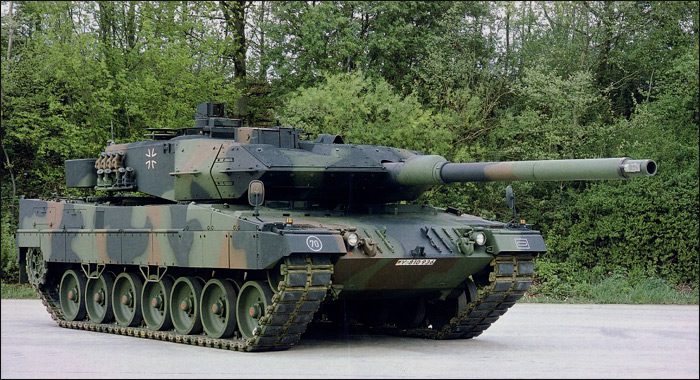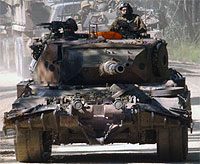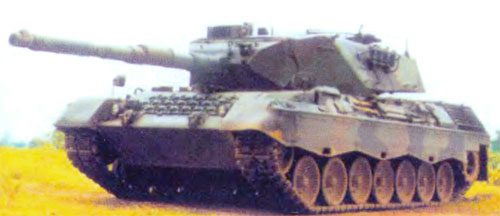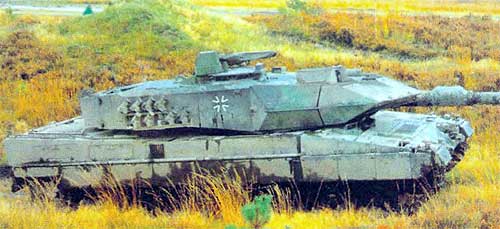
Leopard main battle tank
Content
Leopard main battle tank
But the weight of the Leopard turret - about 9 tons - turned out to be significantly less than that of similar tanks (about 15 tons). The small mass of the turret facilitated the operation of the guidance system and the old turret traverse mechanism, which was used on the M48 Patton tank. On the right in front of the case is the driver's seat. Above it in the roof of the hull there is a hatch, in the cover of which three periscopes are mounted. The middle one is easily removed, and a night vision device is installed in its place to drive the tank in conditions of poor visibility. To the left of the driver's seat is an ammunition rack with a part of the ammunition load, giving the loader relatively easy access to the ammunition load at almost any position of the turret relative to the tank hull. The loader's workplace is located in the turret, to the left of the gun. For access to the tank and exit from it, the loader has a separate hatch in the roof of the tower.
The main battle tank "Leopard-1" on exercises On the right side of the turret next to the loader's hatch, there is a tank commander's and gunner's hatch. The gunner's workplace is in front of the turret on the right. The tank commander is located slightly above and behind him. The main armament of the "Leopard" is the English 105-mm rifled gun L7AZ. The ammunition load, consisting of 60 shots, includes armor-piercing, sub-caliber shells with a detachable pallet, cumulative and armor-piercing high-explosive shells with plastic explosives. One 7,62-mm machine gun is paired with a cannon, and the second is mounted on a turret in front of the loader's hatch. On the sides of the tower mounted grenade launchers for setting smoke screens. The gunner uses a stereoscopic monocular rangefinder and a telescopic sight, and the commander uses a panoramic sight, which is replaced by infrared at night. The tank has a relatively high mobility, which is ensured by the use of a 10-cylinder V-shaped multi-fuel diesel engine MV 838 Ka M500 with a capacity of 830 liters. With. at 2200 rpm and a hydromechanical transmission 4NR 250. The chassis of the tank (on board) includes 7 track rollers made of light alloys with an independent torsion bar suspension, a rear-mounted drive wheel, a front-mounted steering wheel and two supporting rollers. A rather significant vertical movement of the road wheels relative to the tank hull is controlled by limiters. Hydraulic shock absorbers are connected to the balancers of the first, second, third, sixth and seventh suspensions. The tracks of the tracks are equipped with rubber pads, which enable the tank to move along the highway without damaging its coating. "Leopard-1" is equipped with a filter-ventilation unit that ensures the normal activity of the crew for 24 hours, and a fire-fighting equipment system. With the help of equipment for underwater driving, water obstacles up to 4 m deep can be overcome. Communication is carried out using the 5EM 25 radio station, which operates in a wide frequency range (26-70 MHz) on 880 channels, 10 of which are programmable. When using standard antennas, the communication range reaches 35 km. In the early 70s in Germany, in order to improve the combat qualities of the Leopard-1 tank, its phased modernization was carried out. The first modernized model received the designation "Leopard-1A1" (1845 vehicles were produced in four series). The tank is equipped with a two-plane main armament stabilizer, the gun barrel is covered with a heat-insulating casing.
Main battle tank “Leopard-1”. For additional protection of the sides of the hull, side bulwarks are installed. Rubber pads appeared on the caterpillar tracks. Tanks "Leopard-1A1A1" are distinguished by additional external armor of the tower, made by the company "Blom und Voss". It consists of bent armor plates with a layer of artificial coating applied to them, which are attached to the tower with bolted connections. An armor plate is also welded to the front of the turret roof. All this led to an increase in the combat weight of the tank by about 800 kg. The A1A1 series machines have a very distinctive silhouette which makes them easy to recognize. After the next stage of modernization, the Leopard-1A2 model appeared (342 cars were produced). They are distinguished by reinforced armor of the cast turret, as well as the installation of night vision devices without illumination instead of the previous active ones used by the tank commander and driver. In addition, the engine air filters and the filter-ventilation system for protection against weapons of mass destruction have been improved. Externally, tanks of the A1 and A2 series are quite difficult to distinguish. The Leopard-1AZ tank (110 units produced) has a new welded turret with spaced armor. The new tower allowed not only to improve the quality of protection, but also to increase the size of the fighting compartment due to the large niche in its rear. The presence of a niche had a positive effect on balancing the entire tower. A periscope appeared at the disposal of the loader, allowing for a circular view. The Leopard-1A4 model (250 tanks produced) is equipped with a new fire control system, including an electronic ballistic computer, a combined (day and night) commander's panoramic sight with a stabilized P12 line of sight, and a gunner's main sight with an EMEZ 12A1 stereoscopic rangefinder with 8- and 16x magnification. By 1992, the Bundeswehr received 1300 Leopard-1A5 vehicles, which are a further modernization of the Leopard-1A1 and Leopard-1A2 models. The upgraded tank is equipped with more modern elements of the fire control system, in particular the gunner's sight with a built-in laser rangefinder and a thermal imaging channel. Some improvements have been made to the gun stabilizer. At the next stage of modernization, it is possible to replace the 105-mm rifled gun with a smooth-bore 120-mm caliber. The performance characteristics of the main battle tank "Leopard-1" / "Leopard-1A4"
On the basis of the Leopard-1 tank, a family of armored vehicles for various purposes was created, including the Gepard ZSU, the Standard armored repair and recovery vehicle, the tank bridge layer, and the Pioneerpanzer-2 sapper tank. The creation of the Leopard-1 tank was a great success for the German military industry. Many countries ordered these machines in Germany or acquired licenses for their production on their own industrial base. Currently, tanks of this type are in service with the armies of Australia, Belgium, Canada, Denmark, Greece, Italy, Holland, Norway, Switzerland, Turkey and, of course, Germany. The Leopard-1 tanks proved to be excellent during operation, and this was the reason that most of the countries listed above, having started rearming their ground forces, turned their eyes to Germany, where new vehicles appeared - the Leopard-2 tanks. And since February 1994, "Leopard-2A5".
Main battle tank “Leopard-2”The development of the third post-war generation tank began in 1967 as part of the MBT-70 project jointly with the United States. But two years later, it became clear that due to the constantly arising disagreements and the ever-increasing cost, the project would not be implemented. Having lost interest in joint development, the Germans concentrated their efforts on their own experimental tank KRG-70, which was named "Kyler". In this car, German specialists used many design solutions found during the implementation of a joint project. In 1970, Germany and the United States finally moved on to creating their own national tanks. In the same year, an agreement was concluded between the FRG and the USA on the standardization of their tank programs. It provided for the unification of the main armament, ammunition, fire control systems, engine, transmission and tracks. In accordance with this agreement, a new version of the Leopard tank was manufactured in the design of the hull and turret of which spaced multi-layer armor was used, and a new fire control system was installed. In 1976, comparative tests of this tank with the American XM1 were carried out. After the US refused to accept the Leopard-2 as a single NATO tank, the German Ministry of Defense in 1977 placed an order for the production of 800 machines of this type. Serial production of the Leopard-2 main tanks began in the same year at the factories of Krauss-Maffei (the main contractor) and Krupp-Mack Maschinenbau. They produced 990 and 810 of these tanks, respectively, which were delivered to the ground forces from 1979 until mid-1987, when the Leopard-2 production program for the German army was completed. In 1988-1990, an additional order was placed for the production of 150 Leopard-2A4 vehicles, which were to replace the Leopard-1A4 tanks sold to Turkey. Then another 100 units were ordered - this time really the last ones. Since 1990, the production of "Leopards" has been discontinued, however, the vehicles available in the army are being modernized, designed for the period up to 2000. It includes strengthening the armor protection of the hull and turret, installing a tank information and control system, as well as improving the undercarriage units. At the moment, the German Ground Forces have 2125 Leopard-2 tanks, which are equipped with all tank battalions.
Serial sample of the main battle tank "Leopard-2A5". The performance characteristics of the main battle tank "Leopard-2" / "Leopard-2A5"
See also:
Sources:
| ||||||||||||||||||||||||||||||||||||||||||||||||||||||||||||||||||||||||||||||||||||||||||||||||||||
 In July 1963, the Bundestag decided to launch mass production of the new tank. The first tanks, called "Leopard-1", entered the tank units of the Bundeswehr in August 1963. Tank "Leopard" has a classic layout. On the right in front of the hull is the driver's seat, in the turret - in the middle part of the hull the main armament of the tank is installed, the other three crew members are also located there: commander, gunner and loader. In the stern is the power compartment with the engine and transmission. The body of the tank is welded from rolled armor plates. The maximum thickness of the frontal armor of the hull reaches 70 mm at an angle of 60°. The cast tower is constructed with extraordinary care. Its low height is characteristic - 0,82 m to the roof and 1,04 m to the highest point of the commander's observation devices located on the roof. However, the insignificant height of the tower did not lead to a decrease in the height of the fighting compartment of the Leopard-1 tank, which is 1,77 m and 1,77 m.
In July 1963, the Bundestag decided to launch mass production of the new tank. The first tanks, called "Leopard-1", entered the tank units of the Bundeswehr in August 1963. Tank "Leopard" has a classic layout. On the right in front of the hull is the driver's seat, in the turret - in the middle part of the hull the main armament of the tank is installed, the other three crew members are also located there: commander, gunner and loader. In the stern is the power compartment with the engine and transmission. The body of the tank is welded from rolled armor plates. The maximum thickness of the frontal armor of the hull reaches 70 mm at an angle of 60°. The cast tower is constructed with extraordinary care. Its low height is characteristic - 0,82 m to the roof and 1,04 m to the highest point of the commander's observation devices located on the roof. However, the insignificant height of the tower did not lead to a decrease in the height of the fighting compartment of the Leopard-1 tank, which is 1,77 m and 1,77 m.



 German tank Leopard 2A7 +
German tank Leopard 2A7 + Tanks for export
Tanks for export Tanks "Leopard". Germany. A. Merkel.
Tanks "Leopard". Germany. A. Merkel. Sale of Leopards to Saudi Arabia
Sale of Leopards to Saudi Arabia Der Spiegel: about Russian technology
Der Spiegel: about Russian technology